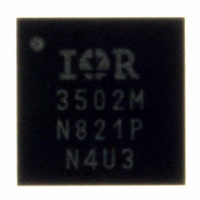IR3502MTRPBF International Rectifier, IR3502MTRPBF Datasheet - Page 10

IR3502MTRPBF
Manufacturer Part Number
IR3502MTRPBF
Description
IC XPHASE3 CONTROLLER 32-MLPQ
Manufacturer
International Rectifier
Series
XPhase3™r
Datasheet
1.IR3502MTRPBF.pdf
(39 pages)
Specifications of IR3502MTRPBF
Applications
Processor
Current - Supply
8mA
Voltage - Supply
8 V ~ 16 V
Operating Temperature
0°C ~ 100°C
Mounting Type
Surface Mount
Package / Case
32-MLPQ
Package
32-Lead MLPQ
Circuit
X-Phase Control IC
Switch Freq (khz)
250kHz to 1.5MHz
Pbf
PbF Option Available
Lead Free Status / RoHS Status
Lead free / RoHS Compliant
Other names
IR3502MTRPBFTR
Available stocks
Company
Part Number
Manufacturer
Quantity
Price
Part Number:
IR3502MTRPBF
Manufacturer:
QFN
Quantity:
20 000
connected to the phase clock input PHSIN of the first phase IC, and PHSOUT of the first phase IC is connected to
PHSIN of the second phase IC, etc. The PHSOUT of the last phase IC is connected back to PHSIN of the control
IC.
During power up, the control IC sends out clock signals from both CLKOUT and PHSOUT pins and detects the
feedback at PHSIN pin to determine the phase number and monitor any fault in the daisy chain loop. Figure 4
shows the phase timing for a four phase converter. The switching frequency is set by the resistor ROSC. The clock
frequency equals the number of phase times the switching frequency.
PWM Operation
The PWM comparator is located in the phase IC. With the PHSIN voltage high, upon receiving the falling edge of a
clock pulse, the PWM latch is set. The PWMRMP voltage begins to increase; the low side driver is turned off, and
the high side driver is turned on after the non-overlap time. When the PWMRMP voltage exceeds the error
amplifier’s output voltage, the PWM latch is reset. This turns off the high side driver and then turns on the low side
driver after the non-overlap time. Along with that, it activates the ramp discharge clamp, which quickly discharges
the PWMRMP capacitor to the output voltage of share adjust amplifier in phase IC until the next clock pulse.
The PWM latch is reset dominant allowing all phases to go to zero duty cycle within a few tens of nanoseconds in
response to a load step decrease. Phases can overlap and go up to 100% duty cycle in response to a load step
increase with turn-on gated by the clock pulses. An error amplifier output voltage greater than the common mode
input range of the PWM comparator results in 100% duty cycle regardless of the voltage of the PWM ramp. This
arrangement guarantees the error amplifier is always in control and can demand 0 to 100% duty cycle as required.
It also favors response to a load step decrease which is appropriate, given the low output to input voltage ratio of
most systems. The inductor current will increase much more rapidly than decrease in response to load transients.
The error amplifier is a high speed amplifier with wide bandwidth and fast slew rate incorporated in the control IC. It
is not unity gain stable.
This control method is designed to provide “single cycle transient response,” where the inductor current changes in
response to load transients within a single switching cycle maximizing the effectiveness of the power train and
minimizing the output capacitor requirements. An additional advantage of the architecture is that differences in the
ground or input voltage at the phases have no effect on operation since the PWM ramps are referenced to VDAC.
Figure 5 depicts PWM operating waveforms under various conditions.
Control IC CLKOUT
(Phase IC CLKIN)
Control IC PHSOUT
(Phase IC1 PHSIN)
Phase IC1
PWM Latch SET
Phase IC 1 PHSOUT
(Phase IC2 PHSIN)
Phase IC 2 PHSOUT
(Phase IC3 PHSIN)
Phase IC 3 PHSOUT
(Phase IC4 PHSIN)
Phase IC4 PHSOUT
(Control IC PHSIN)
Page 10 of 39
Figure 4 Four Phase Oscillator Waveforms
July 28, 2009
IR3502













